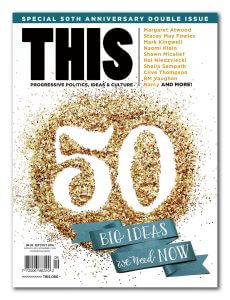Canadians can save the songbirds
Human-made environments have made it tricky for the birds to survive
Moira Farr@moirafarr
 For our special 50th anniversary issue, Canada’s brightest, boldest, and most rebellious thinkers, doers, and creators share their best big ideas. Through ideas macro and micro, radical and everyday, we present 50 essays, think pieces, and calls to action. Picture: plans for sustainable food systems, radical legislation, revolutionary health care, a greener planet, Indigenous self-government, vibrant cities, safe spaces, peaceful collaboration, and more—we encouraged our writers to dream big, to hope, and to courageously share their ideas and wish lists for our collective better future. Here’s to another 50 years!
For our special 50th anniversary issue, Canada’s brightest, boldest, and most rebellious thinkers, doers, and creators share their best big ideas. Through ideas macro and micro, radical and everyday, we present 50 essays, think pieces, and calls to action. Picture: plans for sustainable food systems, radical legislation, revolutionary health care, a greener planet, Indigenous self-government, vibrant cities, safe spaces, peaceful collaboration, and more—we encouraged our writers to dream big, to hope, and to courageously share their ideas and wish lists for our collective better future. Here’s to another 50 years!
Next time you see, or hear the song of, a migratory songbird, stand and applaud. At least, be impressed. This small creature has navigated and survived a harrowing human-made obstacle course of lost forests and farmlands, lethal pesticides, feral and pet cats, and shiny, lit-up, glass buildings that tower into the sky and invite a bird—to crash. If it breeds in its native breeding ground, and makes it back to its wintering habitat, it will be among a rapidly diminishing number of its species and kind to do so successfully. When York University’s Bridget Stutchbury, esteemed ornithologist and author, warns of the looming “silence of the songbirds,” she means it. That’s what we face without a serious turnaround in the way we manage our own habitats. Silence. Death. Shame.
Will we, can we, change the way we farm land, use forest resources, keep our pets, and design our buildings, in order to save the avian beings with whom we share the planet? Thanks to heroes like Michael Mesure, Toronto-based founder of Fatal Light Awareness Program Canada (FLAP), there is now a movement of volunteers who rise early during migration seasons and patrol big-city downtowns to rescue downed birds at the base of skyscrapers—and document the deaths of those that didn’t make it. Mesure took Cadillac-Fairview to court, and garnered bird-friendly bylaws to keep corporate lights out at night, and make windows less crash-inducing. Such bylaws now exist in a growing number of North American cities.
On the domestic scale (birds crash into homes too), more people are taking simple action, including the use of subtly patterned window coatings, to reduce the chances of hearing that dismaying thud against a window and finding a dead or injured bird helpless on the ground. University of Alberta researchers are studying the problem, and publishing their findings and best solutions.
Architects, too, are getting the message. In 2014, the City of Vancouver drafted “Bird-Friendly Design Guidelines,” detailing simple ways urban planners can make a landscape work better for birds—from creating green spaces around buildings, to applying window treatments to reduce or eliminate those heartbreaking crashes. (Check out the annual display of thousands of bird corpses FLAP puts on at the Royal Ontario Museum, to get what is meant by heartbreaking.)
We can choose to do this—or not. But the truth is, if a habitat works better for birds, it works better for us. Let’s sing the praises of anyone who gets that message and flies with it.
Moira Farr was an editor at This Magazine in the early 1990s, and remains a contributing editor. Essays she wrote for This have been reprinted in the Utne Reader, and widely anthologized.